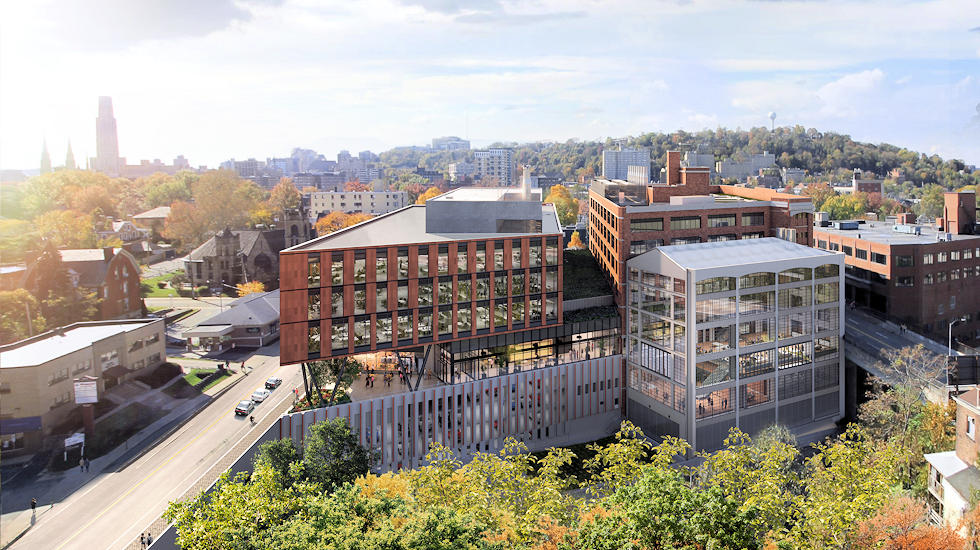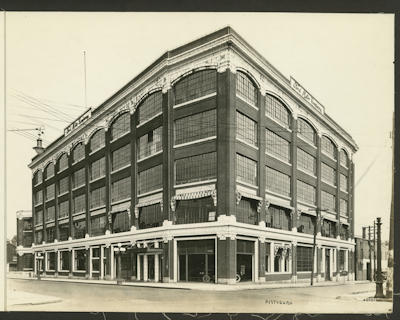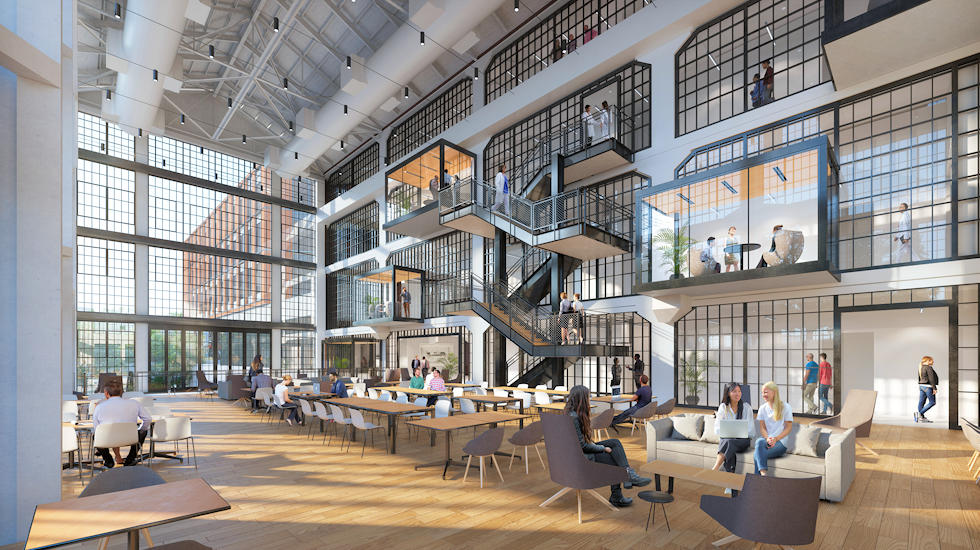The site of a former Ford Motor Co. Model T assembly plant in Pittsburgh is undergoing a major adaptive reuse that will result in a new mixed-use, life science development that marks the city's broader evolution into a national hub of innovation and technology.
The Assembly, as the site is now known, marks one of the latest collaborations between developer Wexford Science + Technology, LLC and its strategic partner Ventas, Inc. (NYSE: VTR), as part of a pipeline agreement launched by the two companies in 2017.
For Ventas CEO Debra Cafaro, The Assembly is a particularly meaningful project. "I am so excited Ventas owns this remarkable landmark in my hometown. Pittsburgh is a city that, like The Assembly, knows how to come back strong after tough times. A historic landmark that our partner Wexford meticulously revived and repurposed beyond its original grandeur, The Assembly is ready for University of Pittsburgh (Pitt) and University of Pittsburgh Medical Center (UPMC) researchers to extend their rich legacy of medical discovery," she says.
Ventas owns 10 million square feet of life science-related real estate and is one of the largest holders in the U.S. market, according to Tim Sanders, senior investment officer at Ventas. The REIT currently has relationships with more than 17 universities and The Assembly is another strategic match. "This is a major part of our growth plan," he says.
"We were early adopters of life science markets with our partnership with Wexford. We made some strategic investments and we're starting to see many of those early decisions come to fruition because the market is hot right now," Sanders says.
Significant Strides
Wexford, a developer specializing in university-anchored "Knowledge Communities," together with partners Ventas, Bank of America, ZGF Architects, and Turner Construction, is transforming the original 250,000 square foot building and an accompanying 105,000 square foot addition into laboratory and office space.
Located in the Bloomfield-Shadyside neighborhood of Pittsburgh, the project stems from collaboration between Wexford and Pitt — the latter looking to reach a new level of medical research collaboration and discovery.
"We understand that progress never comes from standing still," says Mary Beth McGrew, vice chancellor for planning, design, and real estate at Pitt.
"This project will make significant strides in the future of medical research, while providing jobs and generating economic growth in the region."
In November 2021, Turner Construction completed the core and shell for the renovation of the historic building, the centerpiece of the project's first phase of development. Engaged in active leasing, The Assembly will soon welcome its first researchers in advance of an anticipated Spring 2022 public opening. In addition to lab space, it will feature in-building parking with a secured bicycle room and shower facilities; gathering and event spaces; conferencing facilities; a 250-plus seat capacity auditorium; and a restaurant and café.
The project will both preserve a tangible piece of Pittsburgh's legacy and expand horizons for its leading educational institutions. Bordering multiple Pittsburgh neighborhoods, The Assembly will also serve as a bridge between Pittsburgh's East End and the city's new Innovation District
"The Assembly is Pittsburgh's first specialized innovation development coming online as part of the new Innovation District effort," says Sean Luther, executive director of the Pittsburgh Innovation District, the nonprofit leading development advocacy and partnerships in the city.
"The Innovation District is a framework that unites Pittsburgh's globally leading innovation anchors — Pitt, Carnegie Mellon University (CMU) and UPMC — with dynamic private partners like Wexford," Luther says. The initiative is viewed as a platform to better unite the city's talent, research, technology, and capital in new and exciting ways to keep propelling Pittsburgh forward.
'From Steel to Start-ups'
Beginning in the 1870s and spanning the better part of a century, Pittsburgh played a pivotal role in U.S. industrialization and steel production, at one point producing half of the country's steel output. Built in 1915 by the Ford Motor Co. and designed by famed architect John Graham, the Ford Motor Co. Assembly Plant combined the forces of Pittsburgh steel production with Ford's pioneering mass production to create a one-stop-shop for Model Ts.
The plant featured an eight-story main building containing the assembly areas and a vehicle showroom. A six-story crane shed was used to hoist parts unloaded from the adjacent Pennsylvania Railroad tracks to the assembly level. In 2018, the Ford Motor Plant was added to the National Register of Historic Places, solidifying its contributions to Pittsburgh and U.S. architectural history.
"The Assembly's purpose, history, and transformation are unique to Pittsburgh, a city that has continuously reinvented itself through innovation," McGrew says. Both the university and Wexford believed that legacy was worth preserving.
"It's a really special opportunity to honor the legacy of what was in Pittsburgh at that time. And obviously, it's also a really sustainable opportunity to reset, reuse, and to have positive sustainable investment as well," says John Grady, Wexford's senior vice president for the northeast region.
Adaptive reuse is not without its challenges, however. Wexford tackled environmental issues and a total clearing out of the building's massive interior after years of neglect. "It has entailed scraping out a legacy of vacancy that was clouding people's vision of what the building could become," Grady says.
Wexford has had previous experience renovating and repurposing historic buildings in different communities, such as a former tobacco manufacturing facility for Wake Forest Baptist Medical Center in North Carolina and an old power station at South Street Landing in Providence for its collaboration with Ventas, the University of Rhode Island, Rhode Island College, and Brown University.
Once seen as being at the forefront for innovation and production, the unparalleled building infrastructure has lent itself to cutting-edge lab space design. The ceiling heights, the floor loading capacity, and the ability to install HVAC infrastructure throughout the building all made the transition smoother. "The bones of the building are actually really well-suited for modern laboratories," Grady says.
The designers also have salvaged unique features like the original crane shed — the area where vertical transportation of pieces occurred for assembly lines — which was restored and will be repurposed to serve as a meeting and gathering space for the building and the community, according to Grady. Facilities like The Assembly, that are built for commercialization innovation, actually increase public understanding of the technologies themselves, as well as the broad spectrum of careers available and the ways that an industry can drive a community."
Aligning Goals
While the rich history and architecture of the Ford Motor Co. Assembly Plant made it an ideal vehicle for redevelopment, it was not the main catalyst for The Assembly.
"For us at Wexford, it really starts with the partnership," Grady says. "We spent significant time getting to know the University of Pittsburgh, to understand the chancellor and senior leadership's objectives around growing its innovation portfolio," he says.
According to McGrew, the university's leadership hopes to "achieve a new level of medical research collaboration, knowledge-sharing, and discoveries through the use of open lab and shared meeting spaces, in addition to having a positive economic impact in our local communities and region." These goals aligned perfectly with Wexford's well-established model of partnering with universities, academic medical centers, and research institutions to develop innovative, mixed-use communities in urban settings.
As for Ventas, "the Pittsburgh Innovation District checks a lot of boxes for us," Sanders says. These boxes include: a robust science and research community fueled by two top-tier research universities with Pitt and Carnegie Mellon, a desirable cost of living, a pipeline of potential employees, proximity to public transportation, and the potential for commercial tenants to boost funds for community initiatives.
The Assembly is accessible and positioned along the MLK Jr. East Busway and the upcoming Bus Rapid Transit (BRT) system that will streamline commutes for buses from downtown Pittsburgh to the city's eastern neighborhoods. It is also in the vicinity of the University of Pittsburgh Hillman Cancer Center and Shadyside Hospital and a mile from the Pitt campus.
The revival of Pittsburgh with The Assembly is personal for Sanders, who was also born and raised in the city. "I'm a Pittsburgh native so the quality of jobs and opportunities we provide to local residents is meaningful to me," he explains.
"Oftentimes in large cities with active development and gentrification, locals can miss out on the direct benefits, but that's not the case with life sciences communities that create ancillary jobs and opportunities," Sanders adds. As a mixed-use development in a new research community, The Assembly will also create jobs and entrepreneurial opportunities not requiring four-year degrees— from small businesses such as restaurants and caterers for events, as well as lab assistants and building services.
Mark Anthony Thomas, president of the Pittsburgh Regional Alliance, the region's leading business growth organization and an affiliate of the Allegheny Conference on Community Development, also views the community opportunities stemming from life science developments as far-reaching, beyond direct research initiatives. "Facilities like The Assembly, that are built for commercialization innovation, actually increase public understanding of the technologies Community Benefits The Assembly is expected to create opportunities for those historically disconnected from the city's innovation economy.Nareit: Real estate working for you | 41 themselves, as well as the broad spectrum of careers available and the ways that an industry can drive a community," he says.
Thomas believes the greater Pittsburgh community has recognized the potential of The Assembly and has widely supported this type of growth. "There hasn't been the type of friction that a more contested site can prompt because the community has seen that it will help bridge the universities and hospital systems further," he says.
"Wexford's investments also create a critically important platform to intentionally create new opportunities for those in Pittsburgh who have been historically disconnected from Pittsburgh's innovation economy," Luther adds.
Strengthening Life Science Ecosystems
The ongoing COVID-19 pandemic has increased investment in life science infrastructure and highlighted the need for laboratory space globally — and in Pittsburgh specifically.
"The tight geography and unique topography in the Pittsburgh Innovation District limited the availability of top-quality lab and innovation facilities in Pittsburgh," Luther says. "The Assembly keeps Pittsburgh competitive with its global competition and accelerates our unique approach to life science innovation that can solve the world's toughest challenges," he adds.
Grady notes that the pandemic "has raised the awareness of the importance of investing in modern healthcare, research, and commercialization, particularly around immunotherapies and viruses."
Both the Innovation District and the Pittsburgh Regional Alliance will continue to work with Wexford to ensure The Assembly creates jobs, workforce development strategies, and community benefits well beyond the academic and innovation systems. "We are in the early stages of this new innovation hub, and these types of projects are proof points for Pittsburgh and developers looking to invest," Thomas says.
"We are excited about the possibilities awaiting us in the future of medicine through the use of this historic facility," McGrew adds.


